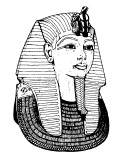Slayer of Gods
Authors: Lynda S. Robinson


CRITICAL ACCLAIM FOR
SLAYER OF GODS
“With a seamless blend of fact and fiction, the author makes ancient palaces and historical figures seem extraordinarily real.
A compelling story does the rest to keep the reader hooked.”
—
Publishers Weekly
“An exquisitely detailed story based on historical fact. The reader becomes totally involved in Meren’s world.”
—
Romantic Times
“A wonderful historical fiction novel… authenticity and plausibility. Historical fiction and mystery aficionados will derive
joy from SLAYER OF GODS.”
“A dramatic ending and a historically plausible interpretation of events, along with a few surprises…an entertaining historical
mystery.”
“A fine frenzy of action… required reading for veterans of the earlier volumes.”
—
Kirkus Reviews
Drinker of Blood
Eater of Souls
Murder at the Feast of Rejoicing
Murder at the God’s Gate
Murder in the Place of Anubis
This book is a work of historical fiction. In order to give a sense of the times, some names or real people or places have
been included in this book. However, the events depicted in this book are imaginary, and the names of nonhistorical persons
or events are the product of the author’s imagination or are used fictitiously. Any resemblance of such nonhistorical persons
or events to actual ones is purely coincidental.
Copyright © 2001 by Lynda S. Robinson
All rights reserved.
Originally published in hardcover by Mysterious Press.
Hachette Book Group
237 Park Avenue
New York, NY 10017
Visit our website at
www.HachetteBookGroup.com
The Grand Central Publishing name and logo are registered trademarks of Hachette Book Group, Inc.
First eBook Edition: September 2009
ISBN: 978-0-7595-2484-2
Contents
CRITICAL ACCLAIM FOR SLAYER OF GODS
Chronology with Selected New Kingdom Rulers of the Late Eighteenth and Early Nineteenth Dynasties
To my uncle, David Womack,
whose love of family and sense of honor
remind me of the qualities
so valued by the ancient Egyptians.
I would like to thank Dr. Bill Petty of Museum Tours for reading this manuscript, for his help in imaging the details of everyday
life in ancient Egypt, and for an unforgettable tour of Egypt. I’m grateful to him for doing what I thought impossible—getting
me to Horizon of the Aten. Bill, you would have made a great advisor or general to King Tutankhamun. I would also like to
express my appreciation to two Egyptians, Mostafa and Khaled, for their expertise and hospitality.
I am also indebted to Dr. James Allen, Curator, Department of Egyptian Art, the Metropolitan Museum of Art, New York, for
his insights into the events in the waning years of Akhenaten’s reign, and most especially his research regarding the fate
of Queen Nefertiti. Readers will find his article, “Akhenaten’s ‘Mystery’ Coregent and Successor” fascinating (in
Amarna Letters
, Volume I, KMT Communications, San Francisco, 1991).
I would also like to thank the members of Chicago House, the University of Chicago mission in Luxor, Egypt, for their gracious
reception, especially Dr. Carlotta Maher and Dr. Raymond Johnson, director. From them I learned the unhappy news that the
great temples at Karnak and Luxor are in even greater danger than most people realize. It may be that—despite the valiant
efforts of the Egyptian government and archaeological missions from around the world—many magnificent reliefs will be gone
in a short fifty years. Many factors contribute to the loss of such archaeological treasures—a rising water table and modern
pollutants among them. It is a great comfort to those of us who admire the achievements of our ancient ancestors that so many
archaeologists, both Egyptian and non-Egyptian, are striving to save this unique cultural heritage.
In Egyptology researchers are constantly uncovering new information, but in the Amarna period—with which this series deals—our
knowledge is often sketchy. The story that follows is based on one of several theories of events that took place during the
reign of Akhenaten. As always, any errors of fact are mine.
The events upon which
Slayer of Gods
is based took place in mid-fourteenth century B.C. when one of history’s unique individuals inherited the throne of Egypt—Akhenaten,
the heretic king. It was Akhenaten who took the unprecedented step of abandoning the worship of Egypt’s ancient gods, especially
the one called Amun. Eventually he even disestablished Amun’s powerful priesthood in favor of a minor sun deity called the
Aten.
The temple of Amun had benefited from royal patronage since—under the god’s banner—Akhenaten’s ancestors overthrew foreign
rule and established the New Kingdom. Now it was fabulously rich and even owned foreign cities and slaves by the tens of thousands.
Such a rich temple had to have been a rival to pharaoh’s power.
Strife between Akhenaten and his enemies became so grave that the king had to move the royal court and government away from
the centers of traditional power—Thebes and Memphis. He built an entirely new city filled with soaring monuments to pharaoh’s
new god and beautiful, expressive art. It was called Horizon of the Aten, and there Akhenaten remained, growing more and more
fanatical in his persecution of Amun, until he died.
Akhenaten’s chief queen was the hauntingly beautiful Nefertiti. She plays a prominent role in the reliefs of her husband’s
reign and may have wielded a great deal of actual power. She bore the king six daughters, and it is the affectionate scenes
of the royal couple with their children that are among the most poignant in Egyptian art.
After the twelfth year of Akhenaten’s reign, Queen Nefertiti’s figure mysteriously vanishes from royal monuments and correspondence.
The reason for her disappearance is unknown. Akhenaten followed his beautiful queen in death a few years later. After a brief
period of uncertainty during which another brother of Akhenaten called Smenkhare may have ruled, the boy king Tutankhamun
inherited the throne of Egypt.
Tutankhamun (first known as Tutankh
aten
) was either Akhenaten’s younger brother or his son. He succeeded when he was between the ages of nine and sixteen and soon
began a complete reversal of Akhenaten’s policies. The royal court moved back to Memphis, and Amun was restored. Tragically,
Tutankhamun died young after a reign of ten years, leaving his successors to carry out the restoration he began.
Late Eighteenth and Early Nineteenth Dynasties
| Late Predynastic | Years B.C. |
| c. 3000 | |
| Early Dynastic | |
| Dynasties 1–2 | ?–2649 |
| Old Kingdom | |
| Dynasties 3–8 | 2649–2134 |
| First Intermediate Period | |
| Dynasties 9–10 | 2134–2040 |
| Middle Kingdom | |
| Dynasties 11–12 | 2134–1797 |
| Second Intermediate Period | |
| Dynasties 13–17 | 1783–1626 |
| New Kingdom | |
| Dynasties 18–20 | 1550–1143 |
| Late Dynasty 18 | |
| Amunhotep III * | 1391–1353 |
| Amunhotep IV/Akhenaten | 1353–1335 |
| Smenkhare | 1335–1333 |
| Tutankhamun | 1333–1323 |
| Ay | 1323–1319 |
| Early Dynasty 19 | |
| Horemheb | 1319–1307 |
| Ramesses I | 1307–1306 |
| Seti I | 1306–1290 |
| Ramesses II | 1290–1224 |
| Third Intermediate Period and Late Period | |
| Dynasties 21–30 | 1070–343 |
| Conquest of Egypt by Alexander | 332 |


Memphis, year five of the reign of the pharaoh Tutankhamun
Beauty the goose shuffled slowly through the forest of legs that blocked her way. She fixed her shortsighted gaze on the hard-packed
earth in search of the occasional cricket. Around her, in the breezy coolness of late evening, servants gossiped in the kitchen
yard. Oblivious to the sounds of lute, harp, and flute that floated from the house, Beauty never paused in her quest even
when she encountered feet arrayed in a line in front of her. Above her women’s voices droned on, chattering and laughing.
Beauty’s small, flat head and beak remained pointed toward the ground. She took another step and pecked at a bare toe. Never
lifting her beady gaze from the spot directly in front of her, Beauty took two more waddling steps, eyed another set of toes,
and snapped at them. They danced out of her way.
She continued down the line of toes, never lifting her head, never varying from her course, certainly not avoiding the feet,
until she reached the back gate. There she nipped at the ankle of the porter in one last ill-tempered and satisfying attack
before she sauntered beyond the high wall that enclosed Golden House, the great mansion of Lord Meren, the Eyes and Ears of
Pharaoh, Friend of the King, and advisor to the young ruler of the Egyptian empire, Tutankhamun.
Had she been a young, fat goose, Beauty would have soon ended up stewing in a pot. But since she was a pet, everyone had to
put up with her menacing ways. She lived up to her name, however. The boldly patterned plumage on her head attracted attention.
She had a black crown, hind neck, and facial marks against a white face, a black lower breast, and russet cheek patches and
upper breast. Her short, thick neck was no hindrance to her bullying ways, nor was her small bill.